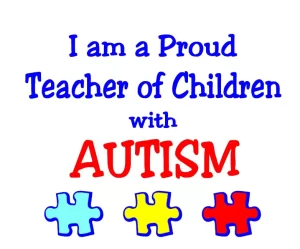As caregivers, our primary goal is to ensure the well-being and development of the children under our care.
Identifying potential developmental challenges at an early stage is crucial for providing timely support and intervention. Autism Spectrum Disorder (ASD) is a neurodevelopmental condition that affects individuals’ social interactions, communication skills, and behavior patterns. Detecting the early signs and symptoms of autism can significantly contribute to early diagnosis and intervention, leading to improved outcomes for children on the spectrum.
In this blog, we will explore the typical signs and red flags that parents, caregivers, and educators should be aware of in young children who may be on the autism spectrum, empowering them to take proactive steps towards seeking professional evaluation and assistance.
Early Signs and Red Flags for Identifying Autism in Young Children:
Social Interaction Difficulties: Children on the autism spectrum often exhibit challenges in social interactions. Some early signs may include:
- Limited eye contact: Difficulty maintaining eye contact or frequently avoiding eye contact during interactions.
- Lack of response to their name: Delayed or absent response when their name is called.
- Limited social smiling: Infrequent or delayed smiles, especially in response to social cues or interactions.
- Reduced interest in others: Showing minimal interest in engaging with peers, caregivers, or family members.
- Difficulty with pretend play: Struggling to engage in imaginative play or imitating others in pretend scenarios.

Communication and Language Differences: Autistic children may have difficulties with communication and language development. Look for the following signs:
- Delayed or absent speech: A lack of verbal communication or significant delays in acquiring language skills.
- Echolalia: Repeating words or phrases heard previously, often without understanding their meaning.
- Limited gestures: Rare use of pointing, waving, or other nonverbal communication gestures.
- Difficulty initiating or maintaining conversations: Struggling to initiate or sustain back-and-forth communication with others.
- Literal understanding: Taking language literally and having difficulty understanding idioms or figurative language.
Repetitive Behaviors and Restricted Interests: Children with autism often engage in repetitive behaviors and develop narrow interests. Watch for the following indicators:
- Stereotypical movements: Repetitive body movements like hand-flapping, rocking, spinning, or finger-flicking.
- Ritualistic behaviors: A strong need for routine and rituals, becoming distressed by changes in the environment or daily activities.
- Intense focus on specific interests: Exhibiting an intense preoccupation with specific topics or objects, often at the expense of other activities.
- Unusual sensory responses: Heightened or diminished sensitivity to sensory input, such as loud noises, certain textures, or bright lights.
Social and Emotional Challenges: Autistic children may experience difficulties in understanding and expressing emotions. Look for the following signs:
- Limited empathy: Difficulty recognizing or understanding others’ emotions and perspectives.
- Emotional regulation issues: Frequent meltdowns or tantrums in response to changes or sensory overload.
- Unusual emotional expressions: Atypical facial expressions or mismatched emotional responses to situations.
- Difficulty with social cues: Misinterpreting or not understanding nonverbal cues, such as body language or facial expressions.
- Trouble forming and maintaining friendships: Struggling to develop and maintain age-appropriate friendships with peers.
It is important to note that every child develops at their own pace, and the presence of one or two of these signs does not necessarily indicate autism. However, if you notice multiple persistent red flags in your child’s behavior, it is advisable to seek a professional evaluation from a healthcare provider or a developmental specialist. Early identification and intervention can make a significant difference in the long-term outcomes and quality of life for children on the autism spectrum.
Conclusion
Recognizing the early signs and red flags of autism in young children is essential for timely intervention and support. By being aware of the typical signs discussed above, parents, caregivers, and educators can play a crucial role in identifying potential developmental challenges in children and seeking professional evaluation when necessary.
Early diagnosis and intervention have been proven to significantly improve outcomes for individuals on the autism spectrum, allowing for tailored support and therapies that promote their social, communication, and behavioral skills.
Remember, each child is unique, and developmental milestones can vary, but if you have concerns about your child’s development, trust your instincts and consult with healthcare professionals who specialize in autism. Together, we can create a nurturing and inclusive environment for all children, ensuring they can thrive and reach their full potential.
http://www.instagram.com/hofaceschool
http://www.facebook.com/hofaceiternationalautismschool




RDWtoXufMgzdOrF
dsXvbNmqhWeTQZC
TqcQnAirWVdOa
ut tenetur dicta et officiis eum qui recusandae voluptates. eveniet quisquam et ducimus quia molestiae praesentium ea necessitatibus sint dolor ad tempora et temporibus et officia. molestias facilis c
IBzmDcVpLgeiHJrj
NuGApRMJvYa
voluptates debitis et sed accusamus ea eos repellat quasi consequatur et ut quaerat consequatur. laborum modi animi dicta reprehenderit vitae perspiciatis ut sapiente vero et eius reprehenderit at. eo
SutrADsN
MGrVhPJojDzHm
uefcr0
molestiae qui et mollitia est. sed cum provident aliquid ullam. enim vitae quam tempore numquam eveniet tempore culpa aliquid totam quasi.